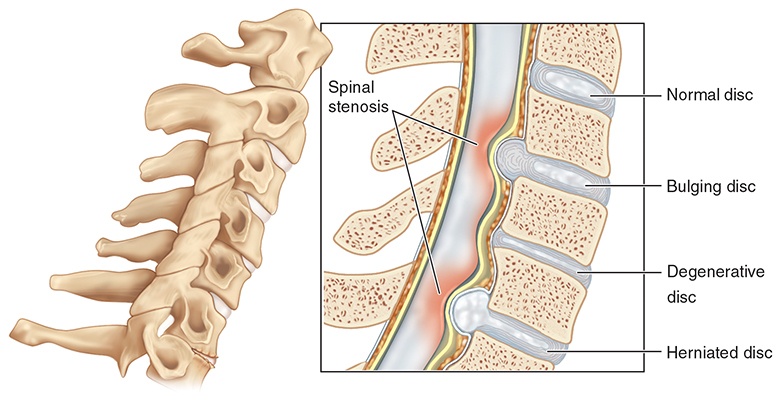Neck and Arm Pain

In the normal spine, the intervertebral disc acts as a cushion between vertebrae. Age, genetics, injury, and everyday wear and tear caused by routine activities can contribute to damage and deterioration of the discs in your neck, causing pain that may radiate toward the arms and/or cause weakness and numbness.
What could be causing my neck and arm pain?
Your doctor has probably taken X-rays and an MRI or CT of your neck and may have found degeneration, a herniated disc, or spinal stenosis.

Degenerative Disc Disease (DDD)
Over time, discs in your spine can lose flexibility, elasticity, and height. When this happens, the discs’ shock absorbing characteristics are reduced and can lead to abnormal motion or alignment and instability of the spine.
Herniated Disc
Degeneration can cause cracks and tears in the outer layer of the intervertebral disc, through which, material inside the disc can be forced out, causing the disc to bulge, break open, or break into pieces, putting pressure on a nerve root or the spinal cord.
Spinal Stenosis
Spinal stenosis is the narrowing of areas in the spine where nerve roots and the spinal cord must travel. This narrowing can place pressure on the nerves and cause pain.
What symptoms could I experience due to degenerative disc disease, spinal stenosis or a herniated disc?
Symptoms of these conditions can include:
- loss of motion and dexterity
- pain in your neck or shoulders
- muscle spasms
- tingling or numbness in the arm or hand
- radiating pain, weakness and/or numbness in your shoulders, arms, and neck
What treatment options are available?
These symptoms may be treated with non-surgical methods for as long as possible. These treatments include rest, ice or heat, weight control, exercise, physical therapy, epidural injections for pain management, and medication.
If non-surgical treatments do not bring relief after a period of time, surgical treatment may be recommended to relieve pressure from the nerves that are causing pain by restoring alignment of the spine and/or the space between the vertebrae.
Read more about potential surgical treatments below.
Anterior Cervical Discectomy and Fusion (ACDF)
Anterior cervical discectomy and fusion is a surgical procedures from the front of the neck in which an interbody spacer is inserted into the disc space to support fusion. This procedure removes and replaces unhealthy discs in the spine, relieves pressure on nerve roots and/or the spinal cord, and allows vertebrae to fuse together over time.
Posterior Cervical Fusion
Posterior cervical fusion is a surgical procedure from the back of the neck in which screws or hooks and rods are inserted into the vertebrae to support fusion. This procedure relieves pressure on nerve roots and/or the spinal cord, and allows the vertebrae to fuse over time.
Motion Preserving Cervical Spine Surgery
Motion preserving cervical spine surgery removes an unhealthy disc in the spine and replaces it with an artificial disc, allowing motion of the cervical spine.
Disclaimer:
The material on this website is intended to be an educational resource only and is not meant to be a warranty or to replace a conversation between a patient and their physician or member of their health care team. Please consult a physician for a complete list of indications, contraindications, precautions, warnings, clinical results and other important medical information that pertains to this procedure. The decision to receive medical treatment is individualized to the patient and the patient’s symptoms. The information presented on this site may not apply to your condition, treatment or its outcome, as surgical techniques vary and complications can occur. It is important to discuss the viability of any surgical procedure with a physician to decide the right treatment option.
